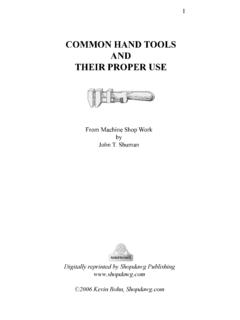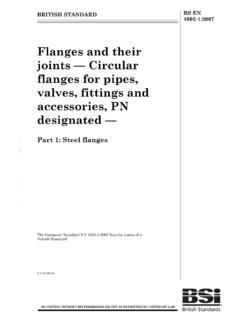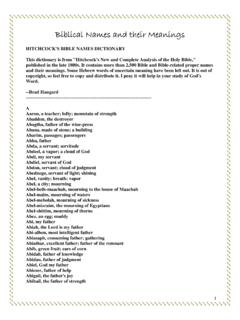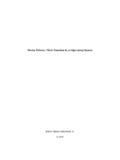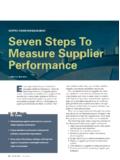Transcription of TYPES OF PLASTIC, THEIR CHARACTERISTICS AND WHY THEY …
1 TYPES OF PLASTIC, THEIR AND WHY THEY MAY BE DANGEROUS TO YOUR HEALTH! The easiest way for a consumer to identify the type of plastic used in a product is to find the resin identification code (also known as the material container code), which is usually molded, formed or imprinted in or close to the centre on the bottom of the container. This system of coding was developed in 1988 by The Society of the plastics Industry (SPI) [ ], which is the Washington, trade association representing the plastics industry. The intent was to provide plastic recyclers which urged the industry to develop such a system with a consistent national system to facilitate recycling of post-consumer plastics through the normal channels for collecting recyclable materials from household waste.
2 The coding system is voluntary for plastic manufacturers, but it's use has become relatively standard on plastic products sold in the and internationally. In Canada, the system is in use and is endorsed by the Canadian plastics Industry Asociation (CPIA) [ ], which provides details on the system through its Environment, Health & Safety strategic unit [ ] and its Environment and plastics Industry Council (EPIC) [ ]. The purpose of the coding system is to make it easier for plastics to be recycled, but the codes also provide consumers with a simple, handy technique for identifying the type of plastic resin used to make a particular product.
3 In accordance with SPI guidelines, the code is deliberately placed in an inconspicuous location on the product because the industry intent is not to influence the consumer's buying decision, just to facilitate recycling of the product. Knowing the code for a particular plastic product, consumers can then inform themselves of the CHARACTERISTICS and potential environmental and health effects associated with usage of that particular type of plastic. Helping consumers in this daunting task is one of the fundamental goals of Life Without Plastic.
4 The table below is a starting point in this information gathering process. For us, this is a continuous process, as this section of our we. Below we provide information we have gathered and reviewed so far, and we welcome your comments and suggestions for any further additions. For example, please send us any plastic-related references you may have, such as peer-reviewed scientific articles (abstracts or full-length versions) relating to the effects of plastics and plastic additives on the environment and health. We cannot guarantee we will use information you provide us, but we will certainly review and consider it.
5 Thank you in advance. Based on the information provided below, you may wish to carefully consider your usage of all plastic products, and especially when food or drink come into contact with those coded 1, 3, 6 and 7 (polycarbonate), all of which contain chemicals that have been shown in peer-reviewed scientific journals to display disturbing potential environmental and/or health effects. Many of the personal food and drink-oriented products with these codes can be replaced by non-plastic alternatives offered by Life Without Plastic.
6 TABLE OF COMMON PLASTIC RESINS AND THEIR CHARACTERISTICS ORGANIZED ACCORDING TO. THE SOCIETY OF THE plastics INDUSTRY (SPI) RESIN IDENTIFICATION (OR MATERIAL CONTAINER) CODE *. CODE & NAME PROPERTIES PRODUCT RECYCLED POTENTIALLY POTENTIAL HEALTH REFERENCES &. SYMBOL (chemical & (largely as APPLICATIONS PRODUCTS** LEACHING EFFECTS OF LINKS. acronym/common) described by the CHEMICALS LEACHED. plastics industry) CHEMICALS. Polyethylene Clarity, Plastic soft drink and Fibre (polyester), Antimony trioxide Workers exposed to Shotyk, W.
7 , Terephthalate strength / water bottles, beer bottles, tote bags, food and is a catalyst antimony trioxide for Krachler, M., (PET or PETE) toughness, mouthwash bottles, beverage regularly used in long periods of time Chen, B. (2006). barrier to gas peanut butter and salad containers, bottles, the production of have shown signs of Contamination of and moisture, dressing containers, clothing, fleece PET plastic resin. chronic toxicity, Canadian and resistance to ovenable film, ovenable wear, furniture, It remains in the including respiratory European bottled heat.
8 Pre-prepared food trays. carpet, luggage. plastic and can tract and skin waters with leach out into food irritation. Antimony antimony from or drink. It has trioxide is known to PET containers. been shown to pass into breast milk J. Environ. leach into water and to traverse the Monit., 8:288 . stored in PET placenta. Exposed 292. water bottles. female workers have This recent study exhibited a higher by a group of incidence than usual geochemists of menstrual problems compared and of late-term concentrations of miscarriages; THEIR antimony in water children tended to bottled in PET.
9 Develop slower than with usual during the first concentrations in twelve months of life. groundwater and in natural water bottled both in polypropylene and glass. They concluded that antimony is leaching from PET. While the ground water contained approximately 2. parts per trillion (ppt) of antimony, freshly bottled water averaged 160 ppt. Samples left in bottles up to six months had levels as high as 630 ppt. (Available online at: g/publishing/journ als/ ?doi=b517844b). High Density Stiffness, Milk, water, juice, Liquid laundry [Research [Research ongoing] [Research Polyethylene strength / cosmetic, shampoo, dish detergent, ongoing] ongoing].
10 (HDPE) toughness, and laundry detergent shampoo, resistance to bottles; trash and retail conditioner, motor chemicals and bags, yogurt and oil bottles; pipes, moisture, margarine tubs, cereal box buckets, crates, permeability to liners. flower pots, garden gas, ease of edging, film and processing, sheet, recycling ease of bins, benches, forming. pens, dog houses, vitamin bottles, floor tiles, picnic tables, plastic lumber, mailbox posts, fencing. Polyvinyl Chloride Versatility, Toys, clear food and non- Packaging, Di(2-ethylhexyl) DEHP and BBzP are Bornehag, C-G.
